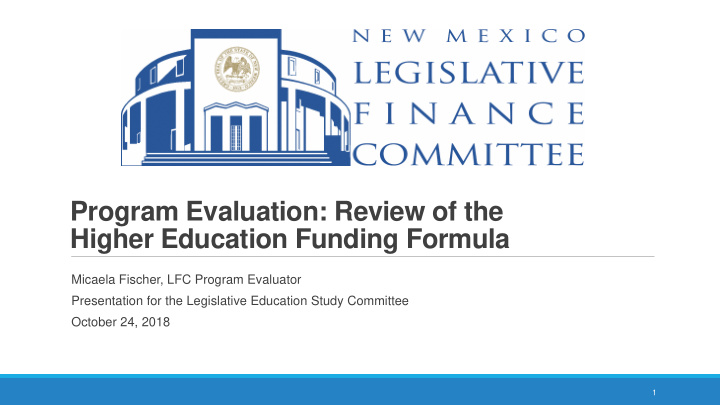



Program Evaluation: Review of the Higher Education Funding Formula Micaela Fischer, LFC Program Evaluator Presentation for the Legislative Education Study Committee October 24, 2018 1
Formula Mechanics (FY19 numbers) 2
… even this low level of performance funding seems to have compelled many colleges to focus on credential completion 3
Over time, the formula will adjust appropriations to be proportional with each college’s performance 4
5
For a few colleges, right-sizing funding via formula equilibrium over time seems appropriate. 6
Equalizing state appropriations to be in proportion with performance would decrease state appropriations to most schools, but…. 7
…would still leave most colleges with more state funding per student than their peers nationally 8
Some colleges are much more sensitive to annual variations in formula funding than others. 9
Unequal local support means formula cuts affect some community colleges more than others 10
Though production of degrees and credentials has increased since formula introduction, most of the increase has come from certificates and associate’s degrees 11
Liberal arts and humanities have been the certificate and associate’s degree majors of most growth. 12
These general degrees do not appear to prepare students for later baccalaureate success. 13
At-risk and STEMH incentive metrics may be too low to combat attainment gaps for low-income students or sufficiently incentivize the production of STEMH degrees. 14
New and revised metrics are needed to ensure quality and encourage colleges to meet broader higher education goals General principal – fewer metrics with more weight, especially as base cut dedicated to performance is cut low. May need to “weed out” less impactful metrics in favor of a few new ones. Some examples of potential new and revised metrics: o New formula measures of job placement and transfer student success to ensure the value of certificate and associate’s programs. o Should increase performance funding dedicated to rewarding credentials conferred to financially at-risk students to make that metric more meaningful. o New, benchmarked metric of spending efficiency to encourage quality business management at colleges (a recommendation of previous LFC evaluation.) 15
Key Recommendations: The Higher Education Department and Legislative Finance Committee should: For the FY20 and FY21 formula run, ratchet back the amount of performance funding dedicated to end-of-course student credit hours by 4.25 percent each year, giving that share to the total awards and at-risk awards measures until the proportions are 30 percent to total awards and 20 percent to at-risk awards. The remaining 16.5 percent of dedicated end-of-course funding should be, over time, transferred to efficiency-related and other recommended measures outlined in the table on the next slide. Between now and FY25, phase out the use of the STEMH, dual credit, 30 credit hour momentum, and 60 credit hour momentum measures and transition instead to new metrics rewarding job placement, transfer students, and transfer student success as outlined in the table on the next slide. 16
17
Recommend
More recommend